Business Law: Legal Options for Incorporation & Termination Rules
VerifiedAdded on 2023/06/15
|5
|1292
|497
Essay
AI Summary
This essay provides an overview of business organizations law in India, focusing on various legal options for business incorporation, including sole proprietorship, partnership, private limited company, and public limited company. It analyzes the suitability of different business structures for Simon's catering and restaurant ventures, highlighting the advantages and disadvantages of each. The essay also discusses the termination processes for registered and unregistered companies under the Companies Act 2013, covering voluntary winding up, tribunal intervention, and the procedures for dissolution. The report concludes by emphasizing the importance of choosing the right business structure to mitigate liabilities and ensure compliance with legal requirements.
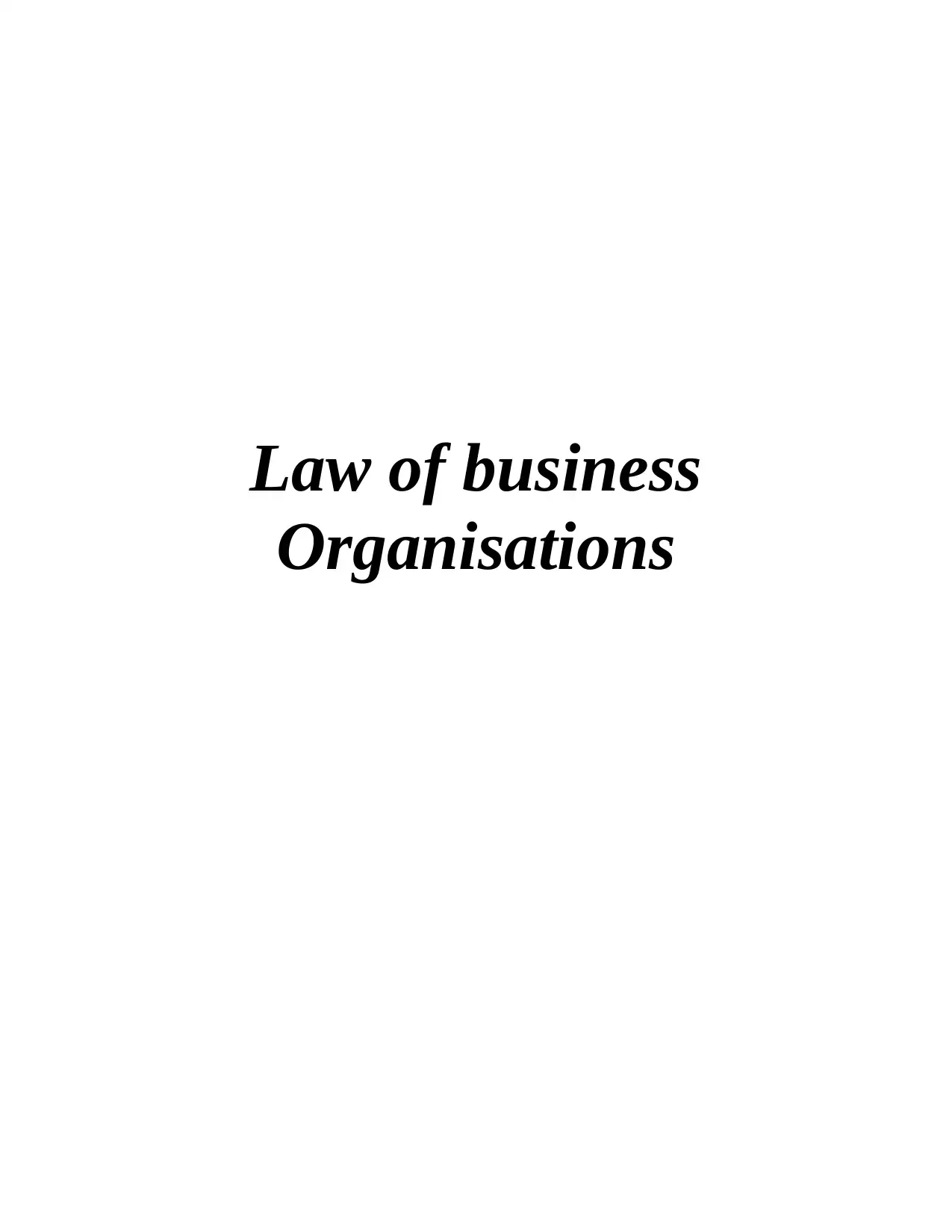
Law of business
Organisations
Organisations
Paraphrase This Document
Need a fresh take? Get an instant paraphrase of this document with our AI Paraphraser
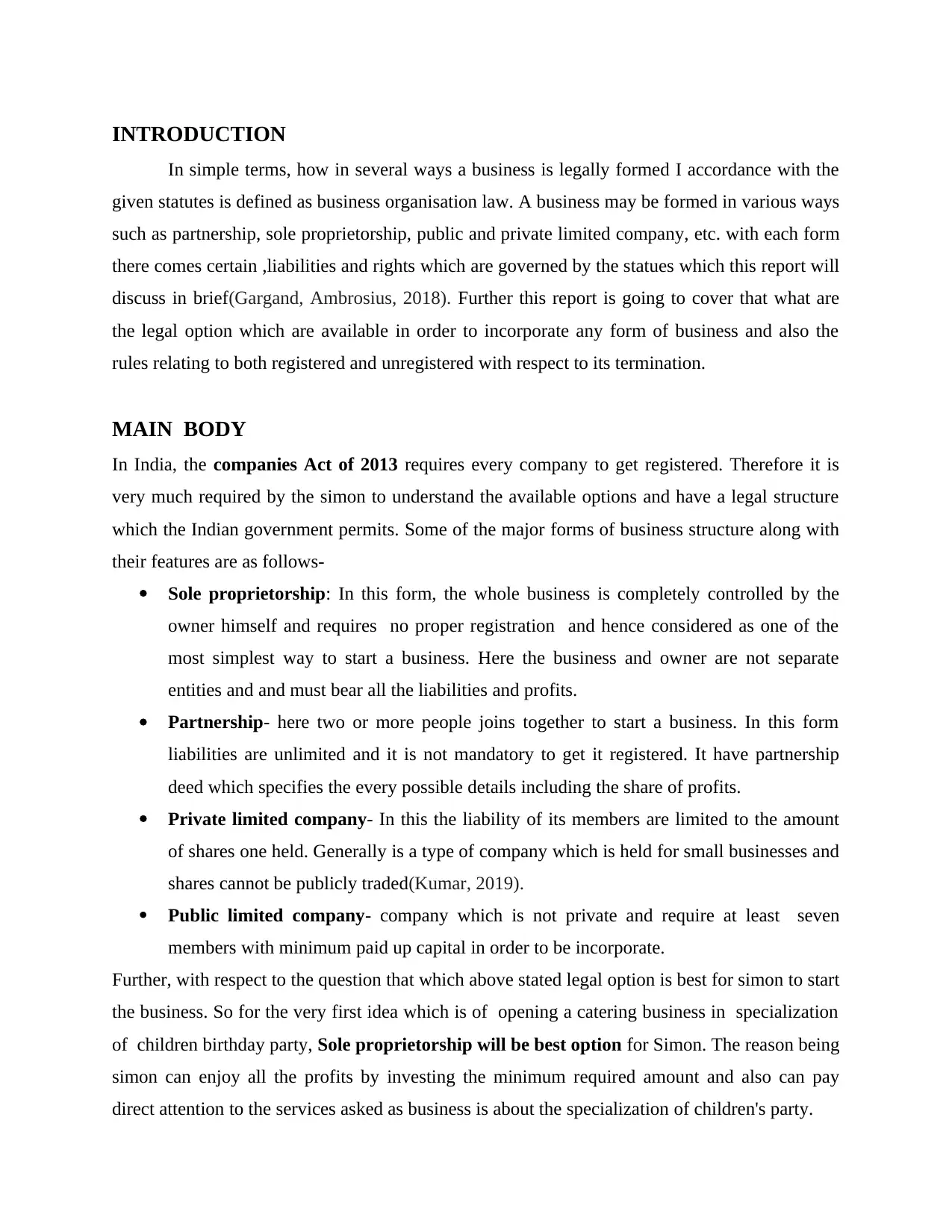
INTRODUCTION
In simple terms, how in several ways a business is legally formed I accordance with the
given statutes is defined as business organisation law. A business may be formed in various ways
such as partnership, sole proprietorship, public and private limited company, etc. with each form
there comes certain ,liabilities and rights which are governed by the statues which this report will
discuss in brief(Gargand, Ambrosius, 2018). Further this report is going to cover that what are
the legal option which are available in order to incorporate any form of business and also the
rules relating to both registered and unregistered with respect to its termination.
MAIN BODY
In India, the companies Act of 2013 requires every company to get registered. Therefore it is
very much required by the simon to understand the available options and have a legal structure
which the Indian government permits. Some of the major forms of business structure along with
their features are as follows-
Sole proprietorship: In this form, the whole business is completely controlled by the
owner himself and requires no proper registration and hence considered as one of the
most simplest way to start a business. Here the business and owner are not separate
entities and and must bear all the liabilities and profits.
Partnership- here two or more people joins together to start a business. In this form
liabilities are unlimited and it is not mandatory to get it registered. It have partnership
deed which specifies the every possible details including the share of profits.
Private limited company- In this the liability of its members are limited to the amount
of shares one held. Generally is a type of company which is held for small businesses and
shares cannot be publicly traded(Kumar, 2019).
Public limited company- company which is not private and require at least seven
members with minimum paid up capital in order to be incorporate.
Further, with respect to the question that which above stated legal option is best for simon to start
the business. So for the very first idea which is of opening a catering business in specialization
of children birthday party, Sole proprietorship will be best option for Simon. The reason being
simon can enjoy all the profits by investing the minimum required amount and also can pay
direct attention to the services asked as business is about the specialization of children's party.
In simple terms, how in several ways a business is legally formed I accordance with the
given statutes is defined as business organisation law. A business may be formed in various ways
such as partnership, sole proprietorship, public and private limited company, etc. with each form
there comes certain ,liabilities and rights which are governed by the statues which this report will
discuss in brief(Gargand, Ambrosius, 2018). Further this report is going to cover that what are
the legal option which are available in order to incorporate any form of business and also the
rules relating to both registered and unregistered with respect to its termination.
MAIN BODY
In India, the companies Act of 2013 requires every company to get registered. Therefore it is
very much required by the simon to understand the available options and have a legal structure
which the Indian government permits. Some of the major forms of business structure along with
their features are as follows-
Sole proprietorship: In this form, the whole business is completely controlled by the
owner himself and requires no proper registration and hence considered as one of the
most simplest way to start a business. Here the business and owner are not separate
entities and and must bear all the liabilities and profits.
Partnership- here two or more people joins together to start a business. In this form
liabilities are unlimited and it is not mandatory to get it registered. It have partnership
deed which specifies the every possible details including the share of profits.
Private limited company- In this the liability of its members are limited to the amount
of shares one held. Generally is a type of company which is held for small businesses and
shares cannot be publicly traded(Kumar, 2019).
Public limited company- company which is not private and require at least seven
members with minimum paid up capital in order to be incorporate.
Further, with respect to the question that which above stated legal option is best for simon to start
the business. So for the very first idea which is of opening a catering business in specialization
of children birthday party, Sole proprietorship will be best option for Simon. The reason being
simon can enjoy all the profits by investing the minimum required amount and also can pay
direct attention to the services asked as business is about the specialization of children's party.
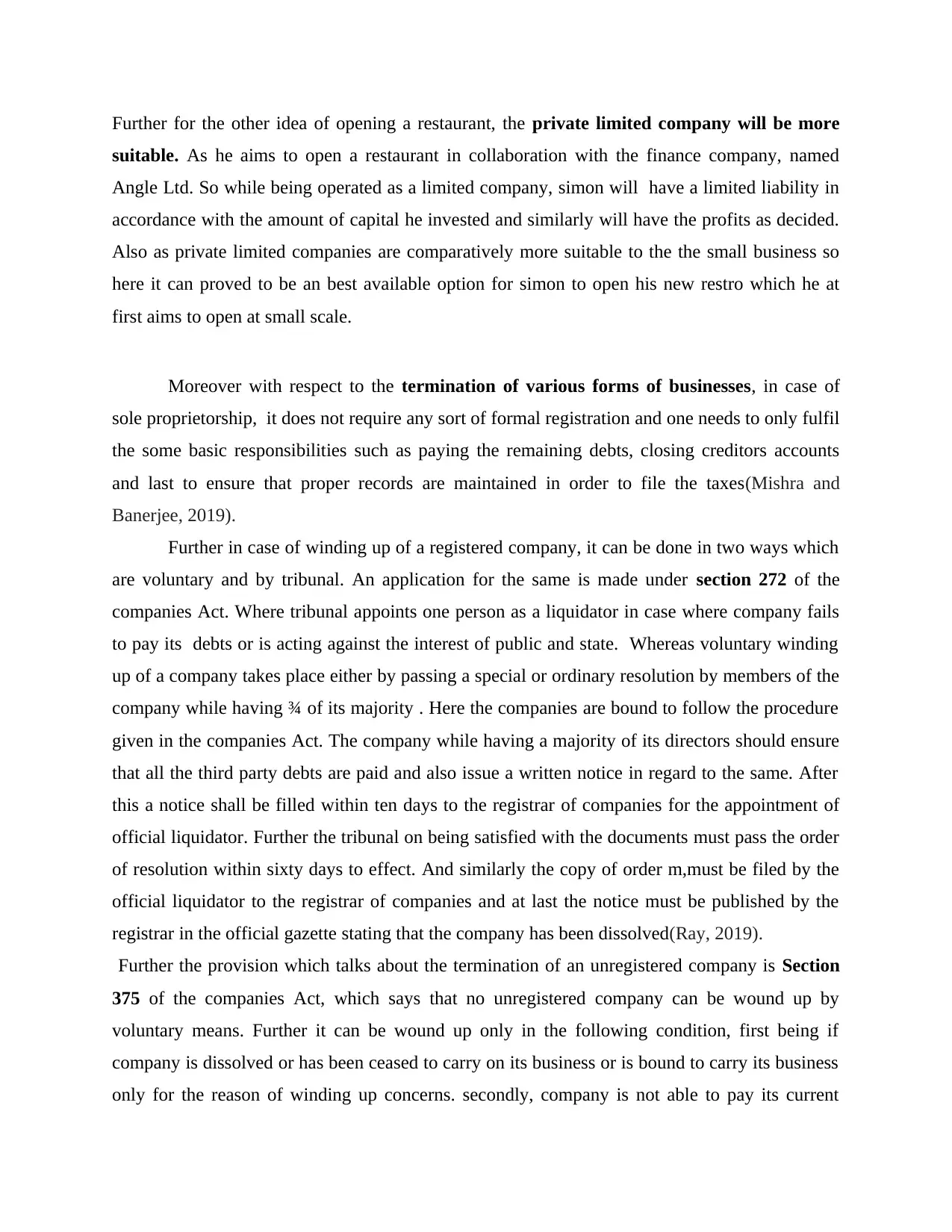
Further for the other idea of opening a restaurant, the private limited company will be more
suitable. As he aims to open a restaurant in collaboration with the finance company, named
Angle Ltd. So while being operated as a limited company, simon will have a limited liability in
accordance with the amount of capital he invested and similarly will have the profits as decided.
Also as private limited companies are comparatively more suitable to the the small business so
here it can proved to be an best available option for simon to open his new restro which he at
first aims to open at small scale.
Moreover with respect to the termination of various forms of businesses, in case of
sole proprietorship, it does not require any sort of formal registration and one needs to only fulfil
the some basic responsibilities such as paying the remaining debts, closing creditors accounts
and last to ensure that proper records are maintained in order to file the taxes(Mishra and
Banerjee, 2019).
Further in case of winding up of a registered company, it can be done in two ways which
are voluntary and by tribunal. An application for the same is made under section 272 of the
companies Act. Where tribunal appoints one person as a liquidator in case where company fails
to pay its debts or is acting against the interest of public and state. Whereas voluntary winding
up of a company takes place either by passing a special or ordinary resolution by members of the
company while having ¾ of its majority . Here the companies are bound to follow the procedure
given in the companies Act. The company while having a majority of its directors should ensure
that all the third party debts are paid and also issue a written notice in regard to the same. After
this a notice shall be filled within ten days to the registrar of companies for the appointment of
official liquidator. Further the tribunal on being satisfied with the documents must pass the order
of resolution within sixty days to effect. And similarly the copy of order m,must be filed by the
official liquidator to the registrar of companies and at last the notice must be published by the
registrar in the official gazette stating that the company has been dissolved(Ray, 2019).
Further the provision which talks about the termination of an unregistered company is Section
375 of the companies Act, which says that no unregistered company can be wound up by
voluntary means. Further it can be wound up only in the following condition, first being if
company is dissolved or has been ceased to carry on its business or is bound to carry its business
only for the reason of winding up concerns. secondly, company is not able to pay its current
suitable. As he aims to open a restaurant in collaboration with the finance company, named
Angle Ltd. So while being operated as a limited company, simon will have a limited liability in
accordance with the amount of capital he invested and similarly will have the profits as decided.
Also as private limited companies are comparatively more suitable to the the small business so
here it can proved to be an best available option for simon to open his new restro which he at
first aims to open at small scale.
Moreover with respect to the termination of various forms of businesses, in case of
sole proprietorship, it does not require any sort of formal registration and one needs to only fulfil
the some basic responsibilities such as paying the remaining debts, closing creditors accounts
and last to ensure that proper records are maintained in order to file the taxes(Mishra and
Banerjee, 2019).
Further in case of winding up of a registered company, it can be done in two ways which
are voluntary and by tribunal. An application for the same is made under section 272 of the
companies Act. Where tribunal appoints one person as a liquidator in case where company fails
to pay its debts or is acting against the interest of public and state. Whereas voluntary winding
up of a company takes place either by passing a special or ordinary resolution by members of the
company while having ¾ of its majority . Here the companies are bound to follow the procedure
given in the companies Act. The company while having a majority of its directors should ensure
that all the third party debts are paid and also issue a written notice in regard to the same. After
this a notice shall be filled within ten days to the registrar of companies for the appointment of
official liquidator. Further the tribunal on being satisfied with the documents must pass the order
of resolution within sixty days to effect. And similarly the copy of order m,must be filed by the
official liquidator to the registrar of companies and at last the notice must be published by the
registrar in the official gazette stating that the company has been dissolved(Ray, 2019).
Further the provision which talks about the termination of an unregistered company is Section
375 of the companies Act, which says that no unregistered company can be wound up by
voluntary means. Further it can be wound up only in the following condition, first being if
company is dissolved or has been ceased to carry on its business or is bound to carry its business
only for the reason of winding up concerns. secondly, company is not able to pay its current
⊘ This is a preview!⊘
Do you want full access?
Subscribe today to unlock all pages.

Trusted by 1+ million students worldwide
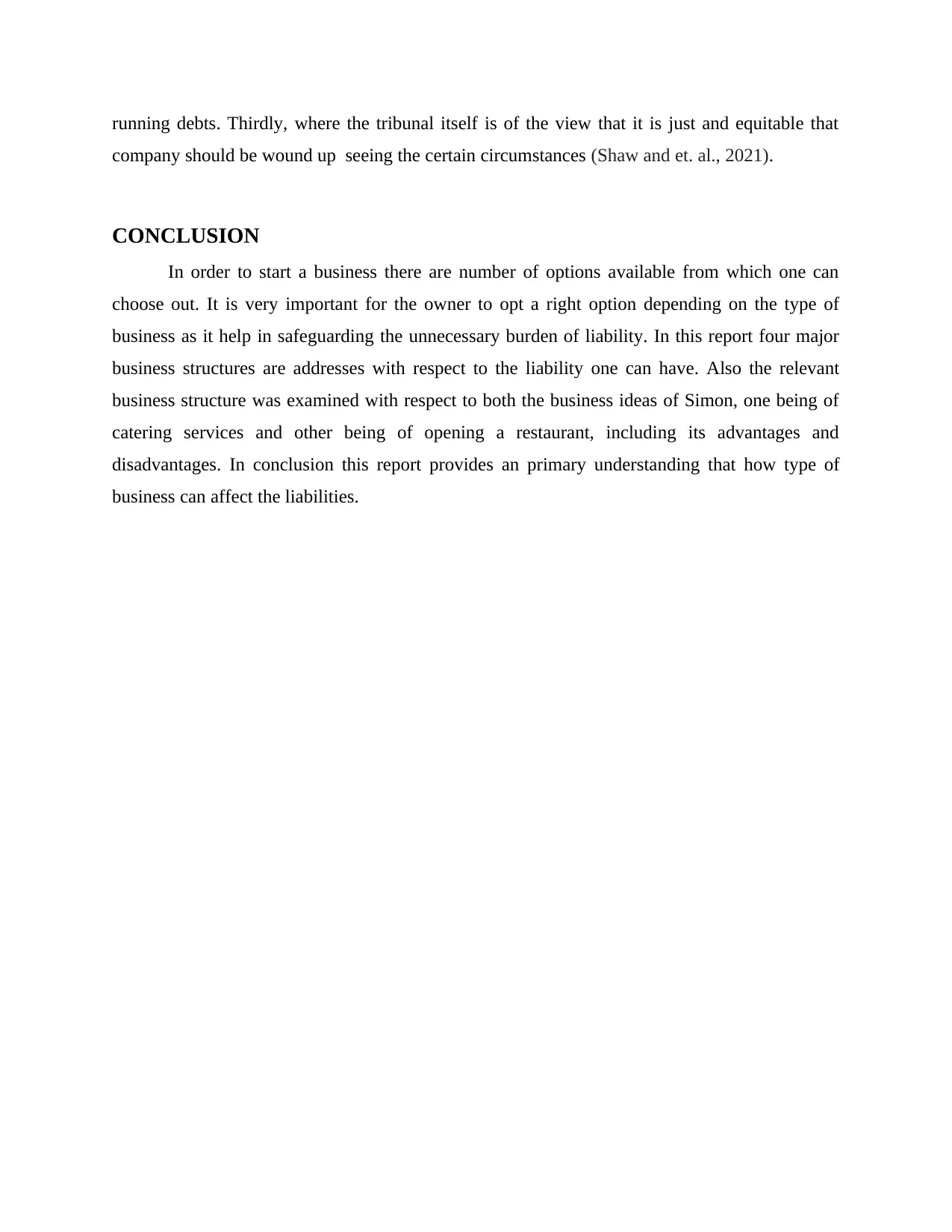
running debts. Thirdly, where the tribunal itself is of the view that it is just and equitable that
company should be wound up seeing the certain circumstances (Shaw and et. al., 2021).
CONCLUSION
In order to start a business there are number of options available from which one can
choose out. It is very important for the owner to opt a right option depending on the type of
business as it help in safeguarding the unnecessary burden of liability. In this report four major
business structures are addresses with respect to the liability one can have. Also the relevant
business structure was examined with respect to both the business ideas of Simon, one being of
catering services and other being of opening a restaurant, including its advantages and
disadvantages. In conclusion this report provides an primary understanding that how type of
business can affect the liabilities.
company should be wound up seeing the certain circumstances (Shaw and et. al., 2021).
CONCLUSION
In order to start a business there are number of options available from which one can
choose out. It is very important for the owner to opt a right option depending on the type of
business as it help in safeguarding the unnecessary burden of liability. In this report four major
business structures are addresses with respect to the liability one can have. Also the relevant
business structure was examined with respect to both the business ideas of Simon, one being of
catering services and other being of opening a restaurant, including its advantages and
disadvantages. In conclusion this report provides an primary understanding that how type of
business can affect the liabilities.
Paraphrase This Document
Need a fresh take? Get an instant paraphrase of this document with our AI Paraphraser
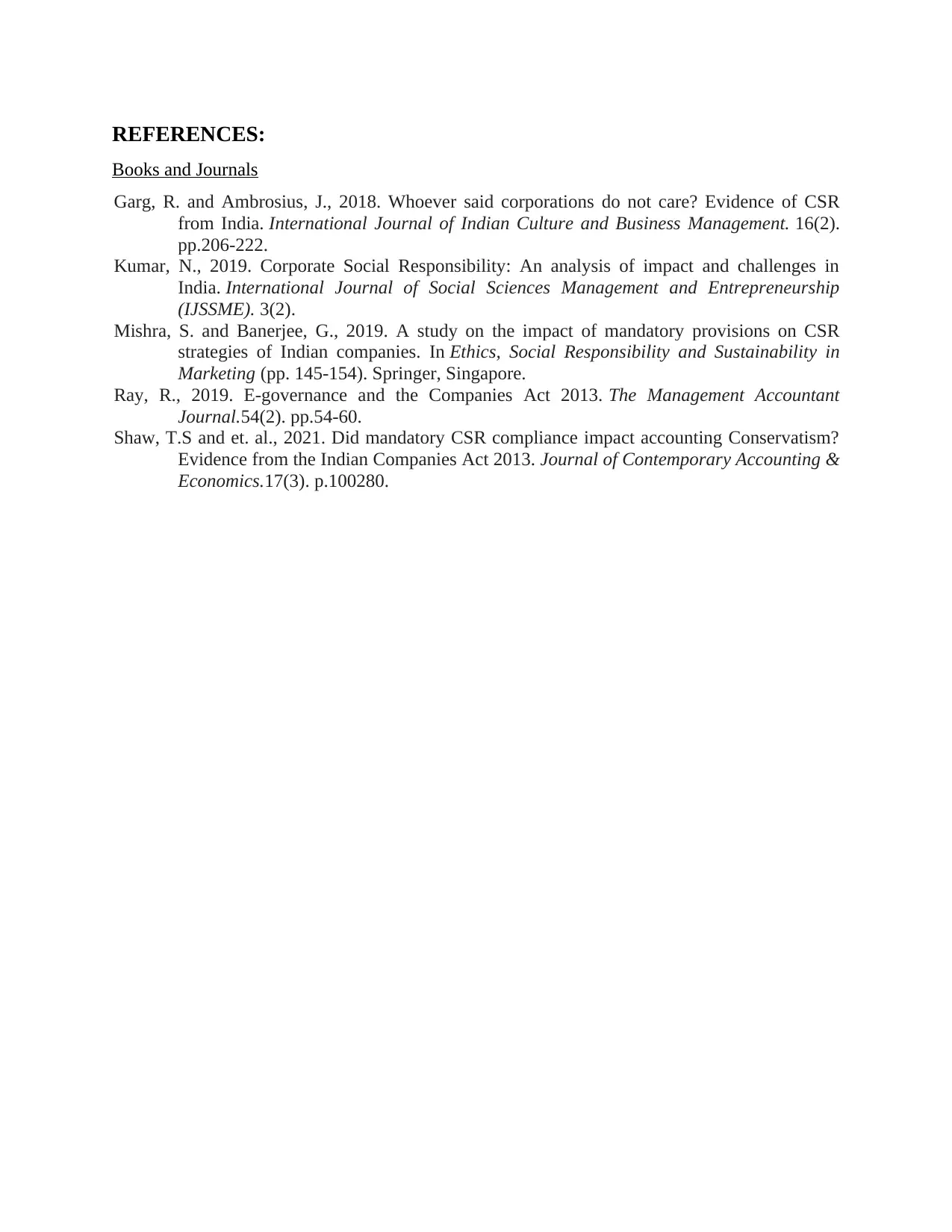
REFERENCES:
Books and Journals
Garg, R. and Ambrosius, J., 2018. Whoever said corporations do not care? Evidence of CSR
from India. International Journal of Indian Culture and Business Management. 16(2).
pp.206-222.
Kumar, N., 2019. Corporate Social Responsibility: An analysis of impact and challenges in
India. International Journal of Social Sciences Management and Entrepreneurship
(IJSSME). 3(2).
Mishra, S. and Banerjee, G., 2019. A study on the impact of mandatory provisions on CSR
strategies of Indian companies. In Ethics, Social Responsibility and Sustainability in
Marketing (pp. 145-154). Springer, Singapore.
Ray, R., 2019. E-governance and the Companies Act 2013. The Management Accountant
Journal.54(2). pp.54-60.
Shaw, T.S and et. al., 2021. Did mandatory CSR compliance impact accounting Conservatism?
Evidence from the Indian Companies Act 2013. Journal of Contemporary Accounting &
Economics.17(3). p.100280.
Books and Journals
Garg, R. and Ambrosius, J., 2018. Whoever said corporations do not care? Evidence of CSR
from India. International Journal of Indian Culture and Business Management. 16(2).
pp.206-222.
Kumar, N., 2019. Corporate Social Responsibility: An analysis of impact and challenges in
India. International Journal of Social Sciences Management and Entrepreneurship
(IJSSME). 3(2).
Mishra, S. and Banerjee, G., 2019. A study on the impact of mandatory provisions on CSR
strategies of Indian companies. In Ethics, Social Responsibility and Sustainability in
Marketing (pp. 145-154). Springer, Singapore.
Ray, R., 2019. E-governance and the Companies Act 2013. The Management Accountant
Journal.54(2). pp.54-60.
Shaw, T.S and et. al., 2021. Did mandatory CSR compliance impact accounting Conservatism?
Evidence from the Indian Companies Act 2013. Journal of Contemporary Accounting &
Economics.17(3). p.100280.
1 out of 5
Related Documents
Your All-in-One AI-Powered Toolkit for Academic Success.
+13062052269
info@desklib.com
Available 24*7 on WhatsApp / Email
![[object Object]](/_next/static/media/star-bottom.7253800d.svg)
Unlock your academic potential
Copyright © 2020–2025 A2Z Services. All Rights Reserved. Developed and managed by ZUCOL.




